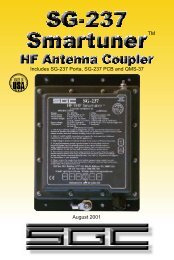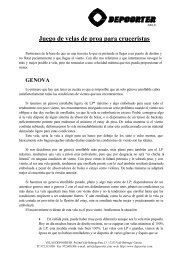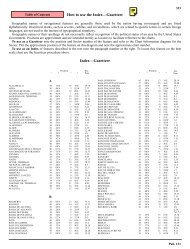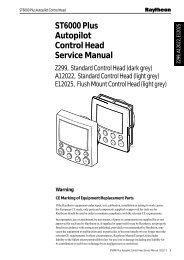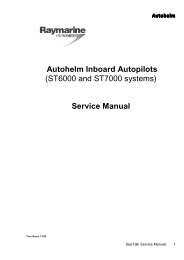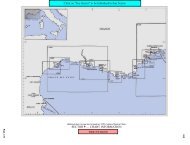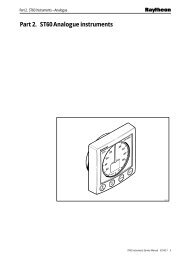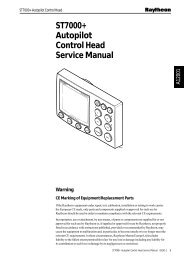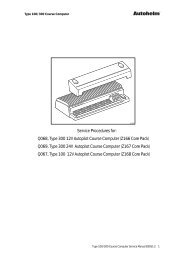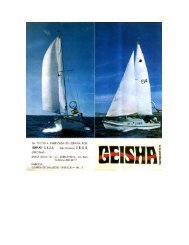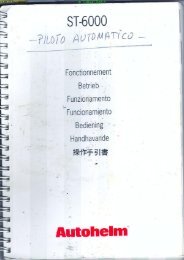You also want an ePaper? Increase the reach of your titles
YUMPU automatically turns print PDFs into web optimized ePapers that Google loves.
49SECTOR 5SOUTH COAST OF TURKEY—KASSAB BAY TO ALOBI BURNU5.0 Plan.—This sector describes the Mediterranean coast ofTurkey from Kassab Bay (Syrian border) to Alobi Burnu. Italso describes the Dhodhekanisos Islands (DodecaneseIslands), which lie in the vicinity of Nisos Meyisti (36˚09'N.,29˚35'E.) and are Greek. The general descriptive sequence is Nand then W.General Remarks5.1 Winds—Weather.—Weather observations in theextreme NE Mediterranean show widely varying wind<strong>directions</strong> with N winds predominating from Novemberthrough February and S winds from March through September.Winds appear to be light to moderate with numerous calms andoccasional winter gales from the NE. The direction of thewinds is considerably influenced by the local topography andvaries sharply from place to place.5.1 Tides—Currents.—The current on the S coast of Turkey,unless affected by gales, generally sets W, with its rate increasingas the distance W from the coasts of Syria andLebanon becomes greater. Some distance from the land thecurrent is weak, but close in to the coast its rate is occasionallyconsiderable.Kassab Bay to Iskenderun Korfezi5.2 Antakya Korfezi (Bay of Antioch) (36˚00'N.,35˚51'E.) lies between Akinci Burnu and Ras al Basit, 28 milesS. Its shores are fringed with rocks and shoals which extend upto 0.3 mile seaward in places.5.2 Kassab Bay (35˚56'N., 35˚55'E.), a small coastal indentation,lies in the SE part of Antakya Korfezi. The coastal borderbetween Turkey and Syria lies in the vicinity of this indentation24 miles SSE of Akinci Burnu.5.2 Anchorage can be taken in Kassab Bay, in a depth of 35m,sand, about 0.4 mile offshore.5.2 Cebeli Akra, a conspicuous peak, rises abruptly to the E ofKassab Bay. Its upper part is entirely bare while its base andridges are thickly wooded.5.2 Asi Nehri flows into the sea 5.2 miles NE of Kassab Bay.This shallow river leads to the town of Antakya. Anchoragecan be taken, in a depth of 16m, about 0.5 mile off the bar atthe river mouth. This anchorage is exposed to W winds; aheavy swell is reported to set in.5.2 Ras al Mina, a conspicuous cape, is located 6 miles NW ofthe mouth of Asi Nehri and can be identified by extensive ruinson its SE side. These ruins are white and are visible for somedistance seaward. The cape is fronted by a small islet andseveral rocks.5.2 Musa Dagi (Koccagiz Tepe), 1,281m high, stands 2.5 milesinland, 11 miles SE of Akinci Burnu. This mountain is thehighest peak of a heavily-wooded range, with numerous deepravines on its W side, down which streams usually run.5.2 Akinci Burnu (36˚19'N., 35˚47'E.), the SE entrance point ofIskenderun Korfezi, is high and steep. It is the W terminationof Kizil Daglar and rises to a height of 1,698m about 4 milesESE. A main light is shown from a structure, 5m high, standingon the N part of this cape.Iskenderun Korfezi5.3 Iskenderun Korfezi (36˚19'N., 35˚47'E.), a wide anddeep gulf, recedes to the NE and is entered between AkinciBurnu and Kararas Burnu (Fener Burnu), 25 miles NW. Thisgulf has an average width of 18 miles, with depths in excess of50m in its central part. The large port of Iskenderun lies in itsSE part.5.3 The tides in the gulf are negligible, but S and W winds maysometimes raise the water level by as much as 0.6m. Windsfrom the N and E may lower it by a similar amount. Duringfresh winds, a strong N current has been observed in the entranceto the gulf.5.3 Ulucinar (Arsuz), a small village situated 7.5 miles NE ofAkinci Burnu, can be identified by a prominent white mosqueand the ruins of its ancient walls. Anchorage can be taken bysmall vessels with local knowledge, in a depth of 8m, sand, offthe village.5.3 Caution.—Iskenderun Korfezi is subject to severe and unpredictablestorms.Iskenderun (36˚36'N., 36˚10'E.)World Port Index No. 448805.4 The port of Iskenderun, consisting of an outer and aninner harbor, is protected on its E side by a range of mountainsand on its W side by an extensive breakwater. In addition, threeoffshore berths lie close NE of the outer harbor.5.4 Winds—Weather.—Winds are usually light during earlywinter, but may be interspersed with squalls and N gales. InMarch, S and SE winds increase, with some periods of strongSW winds. In April, generally variable conditions prevail, withlight winds and calm periods. The wind speed depends greatlyon the local topography and varies from place to place. LightSW winds and land and sea breezes prevail from May throughSeptember. During the autumn, light and variable conditionsare most common.5.4 Depths—Limitations.—Depths in the approaches are inexcess of 35m. A boat harbor, protected by breakwaters, liesclose W of the root of the main breakwater.5.4 The harbors provide 1,812m of total quayage, with berths166 to 200m long having depths of 10 to 12m alongside. Thereare facilities for general cargo, container, bulk, and ro-ro vessels.Vessels up to 185m in length and 11.5m draft can be accommodated.5.4 Three offshore tanker berths, consisting of several mooringbuoys, are situated NNE of the harbor. They lie in depths ofPub. 132



